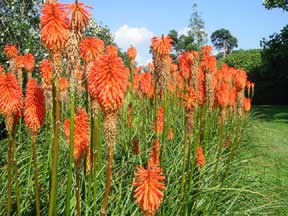Garden News - September 2002
Since my last article way back in March so much has
happened to prevent me sitting down and focusing my mind on any written work,
which is not a report! The only excuse I can come up with is pressure of work
.The main project was to get my own garden ready to open for Henfield Gardens in
Art which proved a great success for the Village. My garden alone took over a
hundred pounds for local charities, not bad for a 20 pence entry charge! Extra
work in various parts of the country and general gardening for a local friend
has all helped to keep me away from the computer. Who wants to be a ‘mouse
potato’ anyway when you could be out in the garden?
get my own garden ready to open for Henfield Gardens in
Art which proved a great success for the Village. My garden alone took over a
hundred pounds for local charities, not bad for a 20 pence entry charge! Extra
work in various parts of the country and general gardening for a local friend
has all helped to keep me away from the computer. Who wants to be a ‘mouse
potato’ anyway when you could be out in the garden?
Knowing the rural areas of Copsale, Nuthurst and Maplehurst
quite well, I thought that I would begin this month by giving you the names of
some wild flowers which would grow well in the area and that are beneficial to
wildlife on the wing.
Meadow sweet [Filipendula ulmaria] this delightful
wayside plant has creamy white flowers between June and August and is well loved by bees.
Purple Loosestrife [Lythrum salicaria ] produces its
red/purple flowers in July and August. This plant seems to have made a hit in the
garden centres this summer.
Marsh Woundwort [Stachys palustris] another
red/purple flowered plant.
Milkmaids or The Cuckoo flower [Cardamine pratensis] There
are so many of these in the hedgerows locally that there is no need to sow extra
seeds but the plant which flowers in April /May is a host for egg laying orange
tip butterflies
Seeds of the above can be autumn sown in damp areas.
 This year has been a troublesome one for potatoes. Scab,
blight, slugs and wireworm are the most common problems. Blight has been
particularly bad , infecting tomatoes that grow in the vicinity.[ Tomatoes are
in the same family as potatoes along with some of the ornamental Solanums
that are becoming popular] Leaves on the potatoes develop grey/brown
patches and ,as the spores of this fungal disease are airborne, infestation
spreads rapidly. Cut off all infected leaves immediately and lift the tubers
before the spores can reach them.
This year has been a troublesome one for potatoes. Scab,
blight, slugs and wireworm are the most common problems. Blight has been
particularly bad , infecting tomatoes that grow in the vicinity.[ Tomatoes are
in the same family as potatoes along with some of the ornamental Solanums
that are becoming popular] Leaves on the potatoes develop grey/brown
patches and ,as the spores of this fungal disease are airborne, infestation
spreads rapidly. Cut off all infected leaves immediately and lift the tubers
before the spores can reach them.
The really common weed problem in the area is the dreaded
Ground Elder, for which, the commonest advice given to garden owners troubled by
this pernicious plant, is to move! However, there is now still time to apply ROOT-OUT.
This weed killer breaks down in the soil to form sulphate of ammonia, which is a
useful plant fertiliser. It is also harmless to wildlife. Found in most good
garden centres,
Try to keep weeds under control, clear up plant debris and
practice good garden hygiene, not only to keep down the slug and snail
population but to prevent the spores of fungal diseases for over wintering in
the soil.
Readers of this ‘spot’ please tell me what it is that
is of garden interest to you and pose a few questions in the forum, GO ON, DO IT NOW. !!!
.Jean
Griffin (F.I. Hort) 2nd September 02
 get my own garden ready to open for Henfield Gardens in
Art which proved a great success for the Village. My garden alone took over a
hundred pounds for local charities, not bad for a 20 pence entry charge! Extra
work in various parts of the country and general gardening for a local friend
has all helped to keep me away from the computer. Who wants to be a ‘mouse
potato’ anyway when you could be out in the garden?
get my own garden ready to open for Henfield Gardens in
Art which proved a great success for the Village. My garden alone took over a
hundred pounds for local charities, not bad for a 20 pence entry charge! Extra
work in various parts of the country and general gardening for a local friend
has all helped to keep me away from the computer. Who wants to be a ‘mouse
potato’ anyway when you could be out in the garden? This year has been a troublesome one for potatoes. Scab,
blight, slugs and wireworm are the most common problems. Blight has been
particularly bad , infecting tomatoes that grow in the vicinity.[ Tomatoes are
in the same family as potatoes along with some of the ornamental Solanums
This year has been a troublesome one for potatoes. Scab,
blight, slugs and wireworm are the most common problems. Blight has been
particularly bad , infecting tomatoes that grow in the vicinity.[ Tomatoes are
in the same family as potatoes along with some of the ornamental Solanums